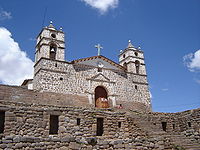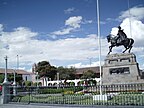Ayacucho
Ayacucho
Huamanga San Juan de la Frontera de Huamanga | |
|---|---|
Top: Ayacucho Basilica Cathedral, Second left: Plaza de Armas de Ayacucho (Ayacucho Square), Second right: Mirador Acuchinay Observatory, Third left: Templo de Santo Domingo de Guzmán, Third right: Mariscal Sucre Monument in Ayacucho Square, Bottom: Ayacucho Triumphal Arch | |
|
UTC-5 (PET) | |
| Area code | 66 |
| Website | http://www.munihuamanga.gob.pe/ |
Ayacucho (Spanish pronunciation:
Its original name, which continues to be the alternative name of the city, dates back to the Incan and Viceregal periods of its history, until its official change by Simón Bolívar in 1825 through a decree to commemorate the battle of Ayacucho during the Peruvian War of Independence. Bolívar issued the decree on February 15, 1825,[4][5] changing the name from "Huamanga" to "Ayacucho",[5] after the battle that decisively established the total independence of the nascent Peruvian Republic.[5][6]
Ayacucho is famous for its 33 churches, which represent one for each year of Jesus' life. Ayacucho has large religious celebrations, especially during the
History
Vestiges of human settlements more than 15,000 years old have been found in the site of Pikimachay, about 25 km north of Ayacucho. From 500 to 900, the region became occupied by the Wari culture, which became known as the first expansionist empire based in the Andes before the Inca Empire.






The
The Spanish colonial founding of Huamanga was led by conqueror Francisco Pizarro on April 25, 1540, who named it San Juan de la Frontera de Huamanga.[11] Due to the constant Incan rebellion led by Manco Inca Yupanqui against the Spanish in the zone, Pizarro was quick to populate the settlement with a small number of Spaniards brought from Lima and Cusco. On May 17, 1544, by Royal decree, Ayacucho was titled La Muy Noble y Leal Ciudad de Huamanga (the most noble and loyal city of Huamanga), the highest designation in the Spanish hierarchy of naming cities. The city's main University was founded on July 3, 1677, as San Cristóbal of Huamanga University. Ayacucho was significant in the colonial era for being an administrative center, a stopping-off point between Lima and Cuzco, and the residence of mercury miner from Huancavelica, as well as local land owners.[12]
On February 15, 1825,
Although the city gained a new name and some fame, the economy declined following independence. There were attempts to revive the city's fortunes, with a planned railway link to Peru's network, but the line was terminated in Huancavelica. A highway was subsequently constructed in 1968.[12] The city's economy is based on agriculture and light manufacturing, including textiles, pottery, leather goods, and filigree ware. It is a regional tourism destination, known for its 33 churches built in the colonial period, and for the nearby battlefield of La Quinua, where the Ayacucho battle was fought in 1824. The University of San Cristóbal was reopened in 1959. The city's population began to increase, but violent political unrest destabilized the region forced migration of many.[12]
In 1980, the far-left terrorist organization known as the Shining Path (Sendero Luminoso) used Ayachucho as its base for its campaign against the Peruvian government, even staging an assault on the Ayacucho prison in 1982. The campaign faded after the leader Abimael Guzmán Reynoso was captured in 1992 and put in prison. The region headed by Ayacucho is rural and one of the poorest of all the country. With the peace of the last 15 years, the citizens work hard to improve the living conditions and attract jobs.
Notable people from Ayacucho
- María Parado de Bellido, heroine in War of Independence.[13]
- Andrés Avelino Cáceres, President of Peru (1886–1890) and (1894–1895)
- Luis Guillermo Lumbreras, archaeologist.[14]
- Alberto Arca Parró, economist and lawyer.[15]
- Raúl García Zárate, guitarist.[16]
- Renata Flores Rivera, singer[17]
Climate
Owing to its high elevation, Ayacucho has a
| Climate data for Ayacucho | |||||||||||||
|---|---|---|---|---|---|---|---|---|---|---|---|---|---|
| Month | Jan | Feb | Mar | Apr | May | Jun | Jul | Aug | Sep | Oct | Nov | Dec | Year |
| Mean daily maximum °C (°F) | 23.6 (74.5) |
23.5 (74.3) |
23.0 (73.4) |
23.8 (74.8) |
23.9 (75.0) |
23.2 (73.8) |
22.7 (72.9) |
23.6 (74.5) |
23.8 (74.8) |
24.9 (76.8) |
25.5 (77.9) |
24.6 (76.3) |
23.8 (74.9) |
| Mean daily minimum °C (°F) | 10.5 (50.9) |
10.5 (50.9) |
10.3 (50.5) |
9.7 (49.5) |
8.2 (46.8) |
7.1 (44.8) |
6.6 (43.9) |
7.7 (45.9) |
9.2 (48.6) |
10.1 (50.2) |
10.7 (51.3) |
10.7 (51.3) |
9.3 (48.7) |
| Average precipitation mm (inches) | 117.1 (4.61) |
101.5 (4.00) |
93.6 (3.69) |
23.8 (0.94) |
23.9 (0.94) |
23.2 (0.91) |
22.7 (0.89) |
23.6 (0.93) |
23.8 (0.94) |
24.9 (0.98) |
25.5 (1.00) |
24.6 (0.97) |
528.2 (20.8) |
| Source: National Meteorology and Hydrology Service of Peru[18] | |||||||||||||
See also
References
- ^ Instituto Nacional de Estadística e Informática, Perfil Sociodemográfico del Perú Archived November 14, 2012, at the Wayback Machine pp. 30.
- ISBN 9781606089477.
Furthermore, the citizens of Ayacucho point with pride to the thirty-three churches that go back to colonial Huamanga (Ayacucho's name then).
- ^ "Copia de Decreto que cambia nombre a Huamanga". Biblioteca Bicentenario. February 15, 1825.
- ^ Peru; S, Justino M. Tarazona (1968). Demarcación política del Perú: 1821-1967 (in Spanish). p. 644.
El Libertador Simón Bolívar expidió el decreto de 15 de febrero de 1825 por el que se cambió el nombre de "Huamanga" por el de "Ayacucho", pues la "victoria de Ayacucho ha afirmado para siempre la Independencia total de la República"
- ^ a b c statutes, Peru (1861). Coleccion de leyes, decretos y órdenes publicadas en el Perú desde el año de 1821 hasta 31 de diciembre de 1859 reimpr. por orden de materias por J. Oviedo (in Spanish).
- ^ Peru (1968). Demarcación política del Perú: recopilación de leyes y decretos, 1821-1967 (in Spanish). Ministerio de Hacienda y Comercio. Dirección Nacional de Estadística y Censos. p. 644.
2°—Que, obtenida la victoria en el Departamento de Huamanga, debe marcarse su nombre, de una manera que perennemente recuerde a aquellos habitantes el origen de su libertad
- ^ "Wari Empire".
- ISBN 9781566398329.
- ^ a b Rowe, John Howland (1946). "Inca Culture at the Time of the Spanish Conquest".
- ISBN 9781851095742.
- ^ David Scott Palmer, "Ayacucho" in Encyclopedia of Latin American History and Culture, vol. 1, p. 245. New York: Charles Scribner's Sons 1996.
- ^ a b c d Palmer, "Ayacucho", p. 245.
- ISBN 978-0719061707.
- ^ Merino, Denis. "La importancia de la memoria". La Primera. Archived from the original on February 16, 2015. Retrieved August 23, 2012.
- ^ "Alberto Arca Parró". University Honors & Awards. University of Indiana. Archived from the original on December 12, 2012. Retrieved August 23, 2012.
- ^ "Guitarras Maestras". La Republica (in Spanish). October 25, 2009.
- ^ Barrientos, Brenda. "Renata Flores & Her Music Are An Act of Indigenous Resistance". www.refinery29.com. Retrieved January 2, 2022.
- ^ "Promedio de temperatura normal para AYACUCHO". National Meteorology and Hydrology Service of Peru. Archived from the original on November 5, 2023. Retrieved November 6, 2023.
Further reading
- Gade, Daniel W. "Regional isolation of Ayacucho, a city in the Peruvian Andes." Yearbook of the Association of Pacific Coast Geographers 29.1 (1967): 111–119. excerpt






